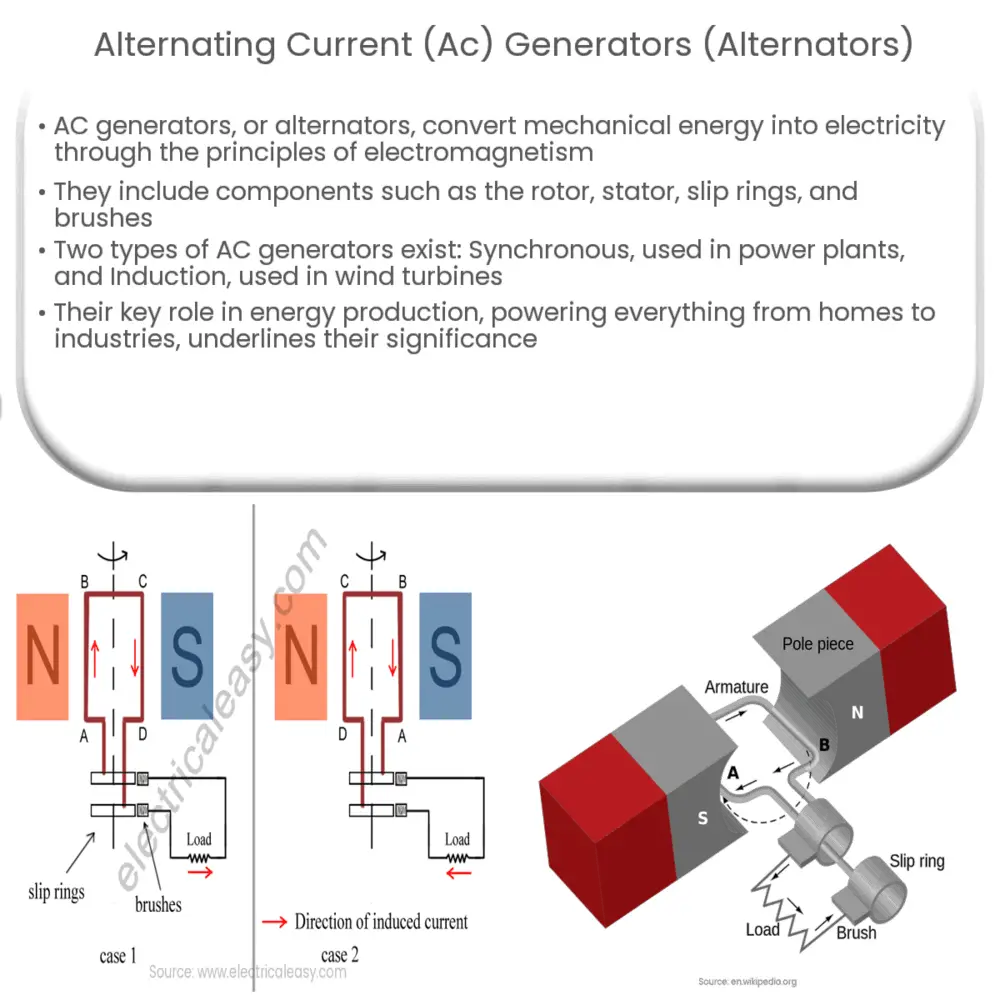Explore the principles, components, and types of AC generators, and understand their crucial role in electricity generation.

Understanding Alternating Current (AC) Generators
Commonly referred to as alternators, Alternating Current (AC) generators are essential components in electrical systems. Unlike Direct Current (DC) generators that produce a steady flow of electricity, AC generators produce electricity that periodically reverses direction.
AC generators have a wide range of applications, including in power plants, automobiles, and as backup power sources during power outages. Their functionality is based on the fundamental principles of electromagnetism and the interaction of magnetic fields with conductive materials to generate electric current.
The Fundamental Principles of AC Generators
The primary principle that governs the operation of an AC generator is Faraday’s law of electromagnetic induction. It states that a change in magnetic field within a closed loop of wire induces an electromotive force (EMF) in the wire. In an AC generator, a coil of wire rotates in a magnetic field, producing a change in the magnetic field, and hence inducing an EMF or voltage across the coil.
Components of an AC Generator
- Stator: The stator is the stationary part of the generator. It comprises a series of electrical coils (windings) held in place within an outer cylindrical frame. The windings are where the output current is generated.
- Rotor: The rotor is the rotating component in the generator. It’s magnetized, and as it spins, it generates a changing magnetic field that induces a voltage in the stator windings.
- Slip Rings: These are electrical connectors that maintain a connection between the rotating rotor and the stationary parts of the generator. They ensure the generated AC can be transmitted out of the generator.
- Brushes: Brushes, typically made of carbon, maintain electrical contact with the slip rings during the rotor’s rotation.
Understanding these components helps to paint a picture of the process involved in the generation of alternating current. The dynamics of these components during operation lead to the cyclical nature of AC output.
Despite their complexity, AC generators are designed and manufactured with precision to perform efficiently in a wide range of conditions. This has been a primary factor behind their ubiquitous presence in today’s world, powering our homes, industries, and much more.
Working Principle of an AC Generator
The operation of an AC generator begins with the rotor. As it rotates, the changing magnetic field induces an electromotive force in the stator windings, as described by Faraday’s Law of electromagnetic induction. The induced electromotive force is an alternating current because of the rotation of the rotor, leading to a constant change in the direction of the magnetic field.
The frequency of the alternating current depends on the speed of the rotor – faster rotation results in higher frequency. The produced AC is then collected via the brushes and slip rings and directed towards the load or the electric grid.
Types of AC Generators
There are two main types of AC generators:
- Synchronous Generators: These are commonly used in power plants. They produce AC at a consistent frequency, synchronizing with the grid’s frequency. Synchronous generators are large and provide a substantial power output.
- Induction Generators: These are generally used in wind turbines. They are simpler and less expensive than synchronous generators but do not maintain a constant frequency. This factor makes them less suitable for direct grid connection without additional equipment.
The Significance of AC Generators
AC generators have revolutionized our world by providing a reliable and efficient means of generating electricity. They are the heart of power production, supplying the electricity that powers our homes, industries, and infrastructure. Furthermore, the ability to easily transform the voltage of AC power has facilitated long-distance transmission of electricity, an integral part of modern power grids.
Conclusion
In conclusion, Alternating Current (AC) generators, or alternators, are indispensable devices that convert mechanical energy into electrical energy. Utilizing principles of electromagnetism and key components like the rotor, stator, slip rings, and brushes, they generate the alternating current that powers our modern world. Whether in large-scale power plants or small-scale renewable energy sources like wind turbines, the AC generator’s fundamental role in energy production cannot be overstated.



